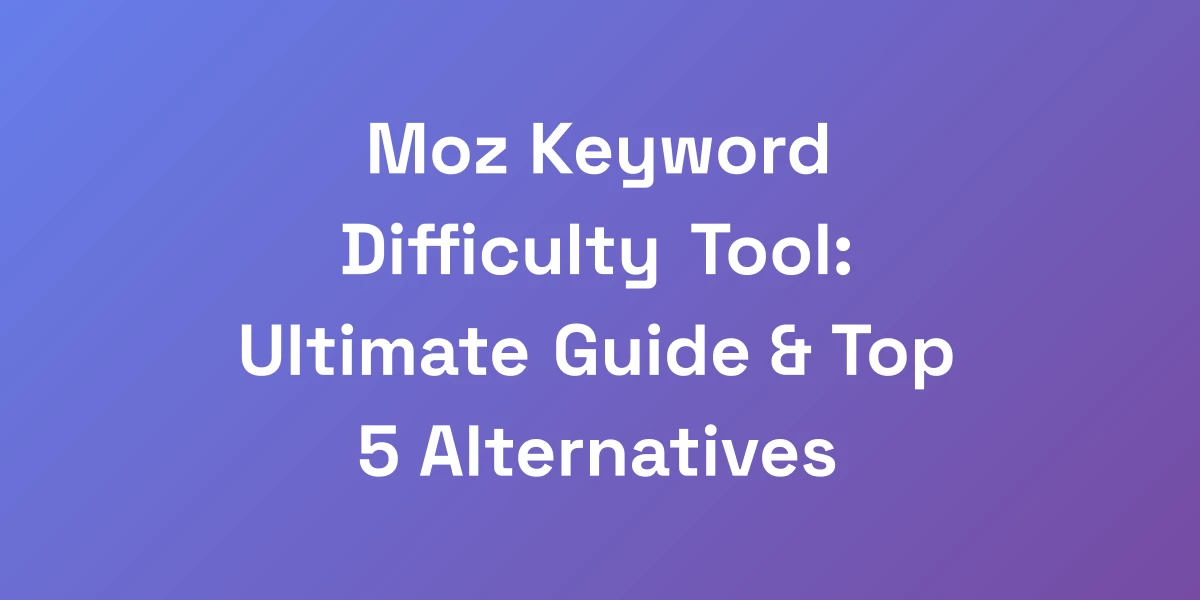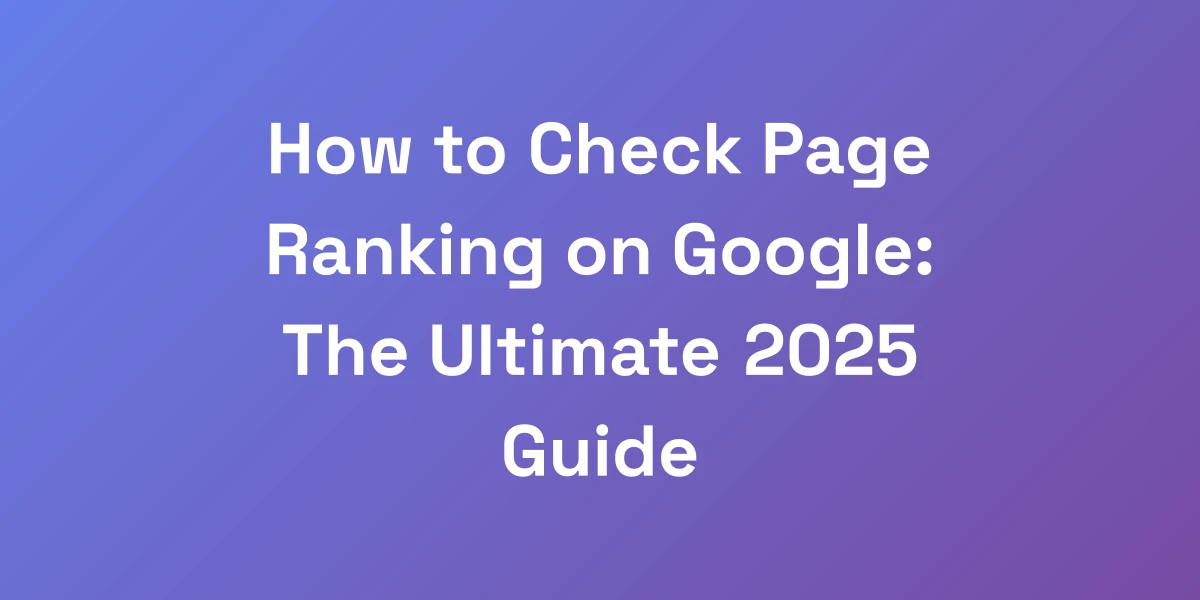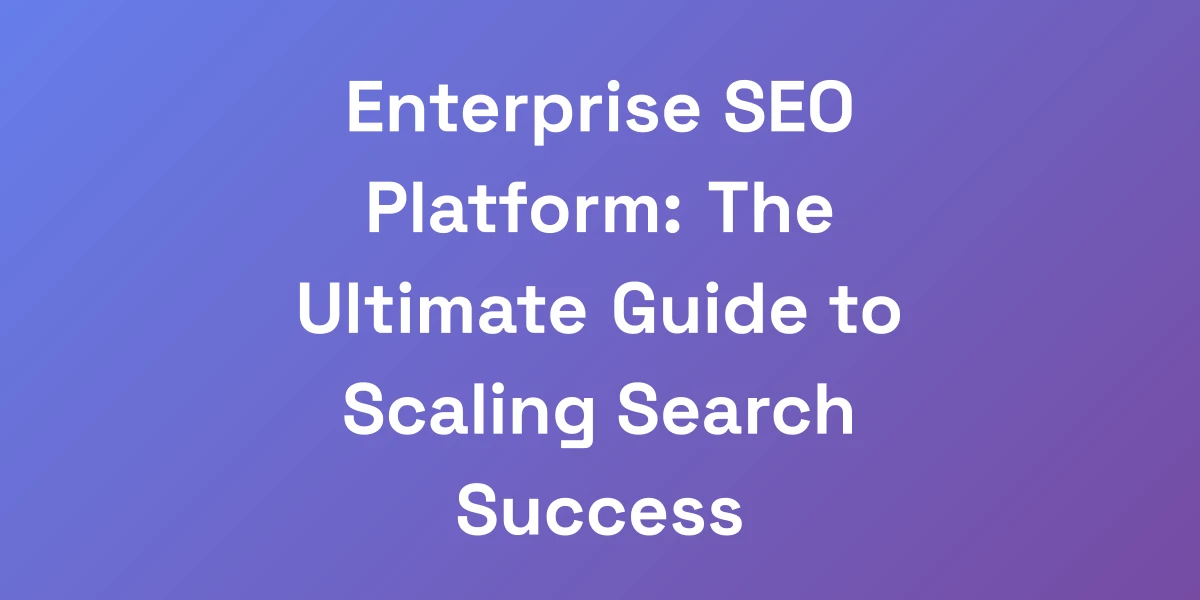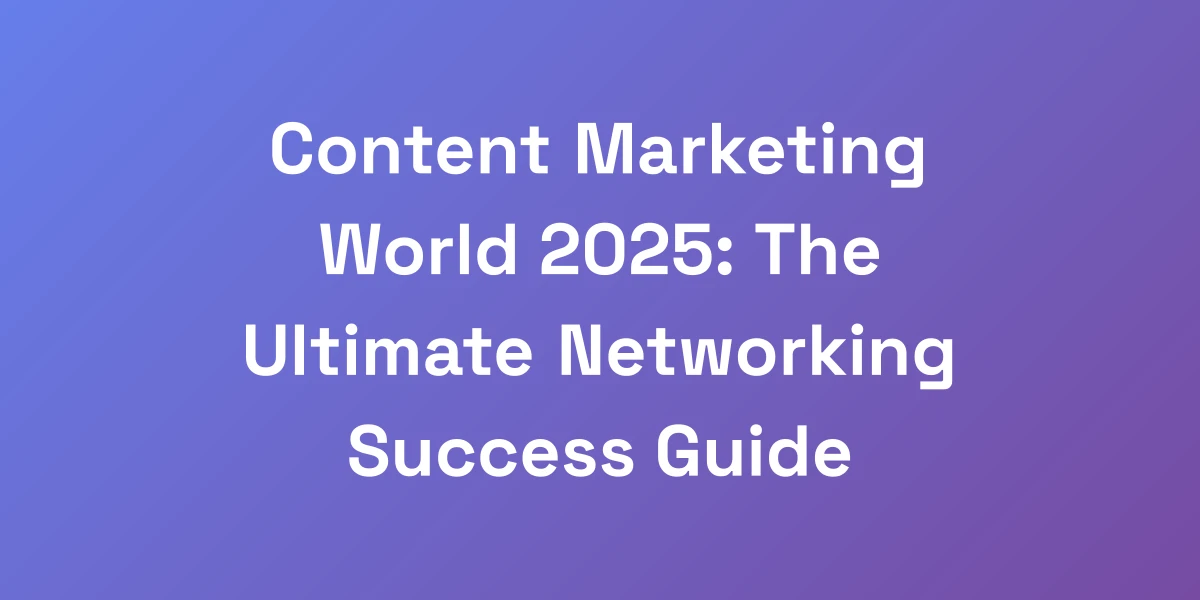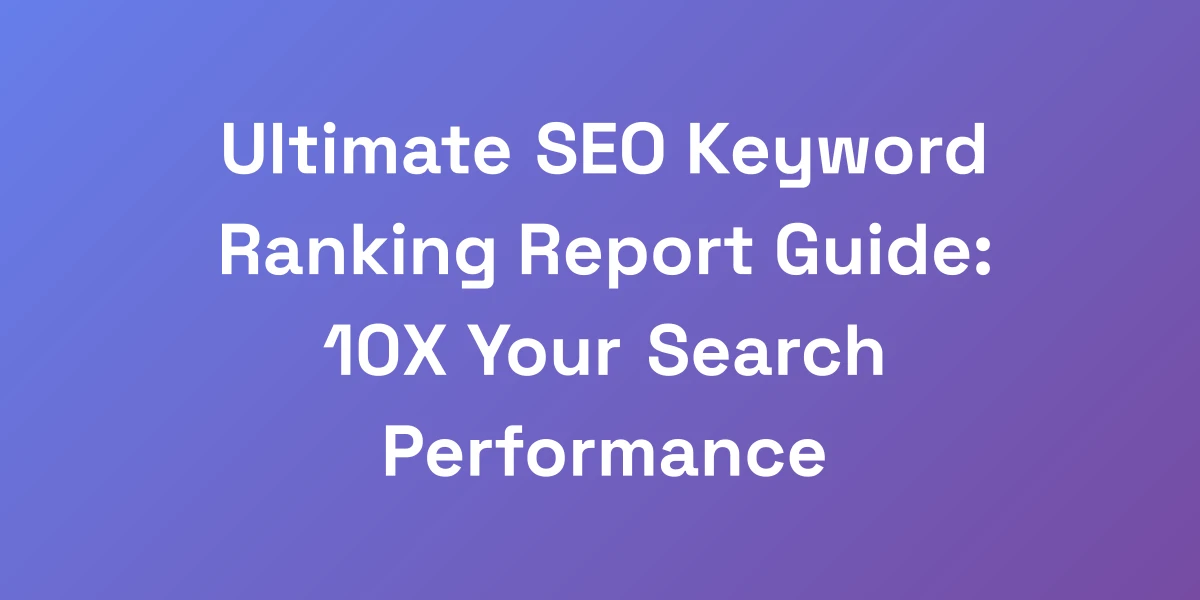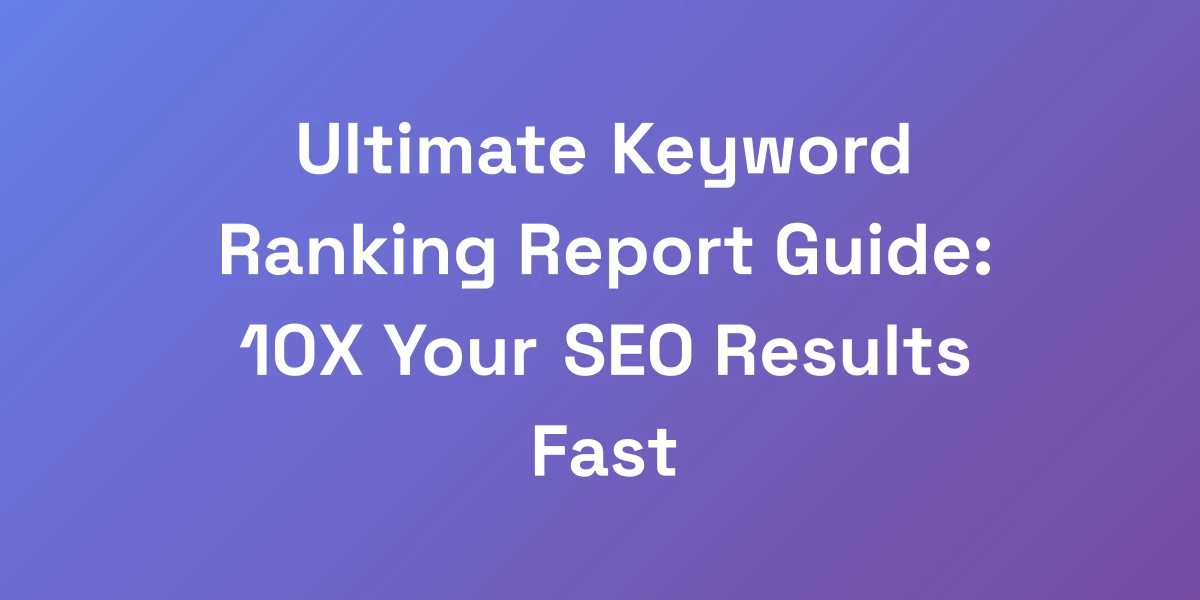
Moz Keyword Difficulty: The Ultimate Guide to Ranking Success
Mar 15, 2025 | By [email protected]
Introduction
Ever felt like you’re throwing spaghetti against the wall with your SEO efforts?
We’ve been there, staring at endless keyword lists, wondering which ones will actually drive traffic.
Enter Moz’s Keyword Difficulty score – a game-changing metric that can transform your SEO strategy from guesswork to precision targeting.
This isn’t just another number on a chart. It’s the secret weapon that separates businesses that waste resources from those that dominate search rankings.
Understanding this metric can save you months of futile effort and put you on the fast track to page one.
But what makes Moz’s Keyword Difficulty score so special? And how can you leverage it to achieve SEO mastery? Let’s break it down.
Understanding Moz’s Keyword Difficulty Score: The Million-Dollar Metric
Let me cut through the BS and tell you exactly what Moz’s Keyword Difficulty score means for your business. This isn’t just another vanity metric – it’s the difference between wasting months of effort or hitting page one with surgical precision.
We’ve invested millions in SEO strategies, and we can tell you that understanding this score is like having a cheat code for Google rankings.
The beauty of Moz’s 1-100 scale isn’t in its simplicity; it’s in how it predicts your probability of ranking before you invest a single dollar.
What Makes Moz’s Difficulty Score Different
Unlike other tools that offer a one-dimensional view, Moz’s Keyword Difficulty score dives deep into the competitive landscape.
It assesses not just the number of competitors, but the quality of their SEO efforts. This means you’re not just seeing how many people are targeting a keyword, but how hard it truly is to outrank them.
By focusing on Domain Authority (DA) and Page Authority (PA), Moz provides a nuanced understanding that goes beyond superficial metrics.
So, when you see a high difficulty score, you know it’s not just tough; it’s a challenging battle against well-established players.
Breaking Down the 1-100 Scale
Moz’s 1-100 scale is more than a simple range; it’s a structured measure that categorizes keywords based on their competitiveness. Learn more about keyword difficulty and how it impacts your SEO strategy.
- 1-20: Low difficulty – ideal for beginners and niche markets. Think of these as the hidden gems waiting to be discovered.
- 21-40: Moderate difficulty – a sweet spot where you can achieve solid rankings with targeted effort.
- 41-60: High difficulty – these keywords demand strategic planning and robust SEO tactics.
- 61-80: Very high difficulty – reserved for highly competitive industries where only top players thrive.
- 81-100: Extremely high difficulty – the Everest of SEO keywords, requiring exceptional authority and resources.
Understanding where your target keywords fall on this scale helps us prioritize our efforts where they can yield the highest returns.
The Real Impact on Your SEO Strategy
So, how does this score influence our SEO plans? It’s simple: it dictates where we allocate resources and energy.
Focusing on low to moderate difficulty keywords allows us to build a strong foundation, gaining traction and authority gradually.
Once we’ve established a solid base, tackling higher difficulty keywords becomes a more achievable goal.
This strategic layering ensures that our SEO efforts are both effective and sustainable, driving consistent growth over time.
By aligning our strategy with Moz’s Keyword Difficulty, we maximize our chances of ranking success without wasting valuable resources.
Common Misconceptions About Keyword Difficulty
There are several myths floating around about keyword difficulty scores. Let’s debunk a few.
- High difficulty means no chance: Not necessarily. With the right strategy, even high-difficulty keywords can be conquered.
- Low difficulty equals easy wins: While easier to rank for, these keywords might not always drive significant traffic.
- Keyword difficulty is static: It fluctuates based on competition and other factors, making regular monitoring essential.
Understanding the truth behind these misconceptions allows us to use the Keyword Difficulty score more effectively, avoiding misguided strategies.
Why Traditional Difficulty Metrics Fall Short
Traditional keyword difficulty metrics often miss the mark by not considering the full spectrum of ranking factors.
They might focus solely on the number of backlinks or the sheer number of competitors, ignoring the quality and relevance of those links. Search engine optimization automation provides a more accurate and actionable metric.
Moz’s approach, however, integrates multiple ranking factors, providing a more comprehensive view. For a detailed comparison, check out this discussion on Moz vs. SEMrush.
By evaluating Domain Authority, Page Authority, and the competitive metrics of the top results, Moz offers a more accurate and actionable metric.
This holistic approach ensures that we’re not just chasing numbers, but optimizing for real, sustainable ranking success.
The Science Behind Moz’s Difficulty Calculation
Here’s the raw truth about how Moz calculates difficulty scores. While others play guessing games, Moz’s algorithm analyzes multiple ranking factors that actually matter.
Think of it as your SEO crystal ball – it examines Domain Authority, Page Authority, and competitive metrics of the top 20 results.
But here’s what nobody tells you: the score isn’t just about competition; it’s about predicting your realistic chances of breaking into those coveted top positions.
Core Components of the Difficulty Score
Moz’s Keyword Difficulty score is built on several core components that work together to provide an accurate measure of competitiveness.
- Domain Authority (DA): Reflects the overall strength of a website’s backlink profile.
- Page Authority (PA): Indicates the strength of a specific page’s backlink profile.
- Competitive Metrics: Analyze the top 20 search results for the target keyword.
- Projected Click-Through Rate (CTR): Estimates the likelihood of a user clicking on a ranking position.
By combining these elements, Moz creates a robust and reliable difficulty score that can guide our SEO efforts effectively.
Domain Authority’s Role in Calculations
Domain Authority is a critical factor in Moz’s calculation. It measures the overall inherent strength of a website to rank in search engines.
A higher DA means the site is likely to rank better, making it more challenging to outrank.
Understanding DA helps us gauge the level of effort required to compete with established sites.
For instance, targeting a keyword where the top-ranking sites have a DA of 80+ requires a significantly different strategy compared to those with a DA of 30.
Page Authority and Its Impact
Page Authority specifically focuses on how well a particular page is likely to rank for a given keyword.
While DA looks at the entire domain, PA zooms in on individual pages, giving us insight into the competitiveness of specific content.
This differentiation allows us to tailor our content strategy more precisely, ensuring we target the right pages and opportunities.
For example, a high PA on a competitor’s page indicates strong content optimization, pushing us to enhance our content quality and relevance.
Competitive Metrics Analysis
Moz doesn’t stop at DA and PA. It dives into competitive metrics, analyzing the top 20 search results for the keyword.
This includes evaluating the strength and strategies of these pages, providing a clearer picture of what it takes to rank.
By understanding the competitive landscape, we can identify gaps and opportunities to position our content more effectively.
For instance, if the top pages are rich in multimedia content and user engagement, our strategy should incorporate similar or superior elements.
Machine Learning Elements in Scoring
Moz leverages machine learning to continually refine its difficulty scores.
This technology allows the algorithm to adapt to changes in search engine behavior and ranking factors.
As Google evolves, so does Moz’s understanding of what drives rankings, ensuring the difficulty score remains relevant and accurate.
This dynamic approach means we are always equipped with up-to-date insights, making our SEO strategies more resilient and effective.
By integrating SEO automation tools, Moz’s algorithm enhances its analysis, providing even more precise difficulty scores.
Recent Algorithm Updates and Changes
SEO isn’t static, and neither is Moz’s Keyword Difficulty score.
Recent algorithm updates have emphasized the importance of user experience and content quality, factors that Moz integrates into its scoring system.
These changes mean that the difficulty score now better reflects the real-world challenges of ranking, considering factors like E-E-A-T (Experience, Expertise, Authoritativeness, and Trustworthiness).
Staying abreast of these updates ensures our strategies remain aligned with Google’s latest ranking criteria, keeping us competitive.
Leveraging Keyword Difficulty for Strategic Advantage
Stop throwing darts in the dark. We’re about to show you how to turn Moz’s Keyword Difficulty score into your competitive advantage.
The game-changing approach isn’t about avoiding high-difficulty keywords – it’s about strategically selecting battles you can win.
We’ve seen businesses 10x their organic traffic by properly balancing difficulty scores with search volume and commercial intent.
Here’s the framework that separates the amateurs from the pros.
Creating Your Difficulty Threshold Strategy
The first step is establishing a difficulty threshold – a score that aligns with your current SEO capabilities and resources.
For new websites, we recommend starting with keywords that have a difficulty score below 40.
This allows for quicker wins and builds a foundation of authority that you can leverage to tackle more competitive keywords later.
Setting a threshold helps in prioritizing keywords that offer the best balance between effort and reward.
For example:
- New Sites: Target keywords with a difficulty of 20-40 to build initial authority.
- Established Sites: Expand to 40-60 to capture more competitive traffic.
- Authority Sites: Aim for 60+ to dominate high-competition niches.
Balancing Difficulty with Search Volume
It’s not enough to chase low-difficulty keywords; we need to ensure they drive meaningful traffic.
Balancing difficulty with search volume ensures that the keywords you target can deliver significant results.
For instance, a keyword with a difficulty score of 35 but a monthly search volume of 10,000 is far more valuable than a score of 25 with only 100 searches.
This balance helps us prioritize efforts on keywords that offer both achievability and substantial traffic potential.
- High Volume, Low Difficulty: Ideal but rare. Great for quick wins.
- High Volume, High Difficulty: Requires strategic planning and resource allocation.
- Low Volume, Low Difficulty: Good for niche targeting and building authority.
Commercial Intent vs. Difficulty Analysis
Not all keywords are created equal. Understanding the commercial intent behind a keyword is crucial.
Keywords with high commercial intent often have higher difficulty scores because they attract strong competition.
However, targeting these keywords can lead to higher conversion rates and better ROI.
By analyzing the commercial intent, we can make informed decisions about which high-difficulty keywords are worth the investment.
For example:
- Transactional Keywords: High intent, often higher difficulty. E.g., “buy running shoes.”
- Informational Keywords: Lower intent, varying difficulty. E.g., “best running shoes for beginners.”
Quick Wins vs. Long-term Investments
SEO is a marathon, not a sprint. We need to balance quick wins with long-term investments.
Quick wins come from targeting lower-difficulty keywords that can be ranked quickly, providing immediate traffic boosts.
Long-term investments involve building content around higher-difficulty keywords that will drive sustainable traffic over time.
This dual approach ensures steady growth while capitalizing on immediate opportunities.
- Quick Wins: Blog posts targeting niche topics.
- Long-term Investments: Comprehensive guides aimed at competitive keywords.
Competitor Gap Analysis Using Difficulty Scores
Understanding where your competitors stand is key to identifying gaps in your strategy.
By analyzing their Keyword Difficulty scores, we can spot opportunities where competitors are weak or absent.
This allows us to target keywords that they haven’t fully optimized for, giving us a strategic edge.
For instance, if a competitor excels in high-difficulty keywords but neglects mid-tier ones, we can focus our efforts there to capture untapped traffic.
ROI Calculation Based on Difficulty
Determining the return on investment for each keyword is essential for prioritizing efforts.
By correlating difficulty scores with potential traffic and conversion rates, we can allocate resources more efficiently.
This ensures that our SEO investments yield the highest possible returns.
- Low-Difficulty Keywords: Lower investment, quicker ROI.
- High-Difficulty Keywords: Higher investment, sustained ROI.
Example:
- A keyword with a difficulty of 30 and a conversion rate of 5% might yield a higher immediate ROI than a keyword with a difficulty of 70 and a conversion rate of 10% due to lower effort and quicker wins.
Advanced Techniques for Beating High-Difficulty Keywords
Let’s talk about what really works when you’re up against high-difficulty keywords. We’re not talking about basic on-page SEO – we’re talking about advanced strategies that actually move the needle.
The secret isn’t avoiding difficult keywords; it’s about creating a systematic approach to dominating them.
Here’s the exact playbook we’ve used to rank for keywords that were supposedly “impossible” to crack.
Content Superiority Framework
To outrank competitors with high-difficulty keywords, your content must be superior in every way.
- Depth and Breadth: Cover the topic comprehensively, answering all possible user queries.
- Engagement: Use multimedia elements like videos, infographics, and interactive content to keep users engaged.
- Quality: Ensure your content is well-researched, accurate, and provides unique insights.
By creating content that offers more value than your competitors, you position yourself as the go-to resource, increasing your chances of ranking higher. Leveraging business blogging strategies can further enhance your content’s authority and reach.
Authority Building Tactics
Building authority is crucial when targeting high-difficulty keywords. Here’s how we do it:
- Backlink Acquisition: Secure high-quality backlinks from reputable sites to boost your Domain Authority.
- Thought Leadership: Publish authoritative content that showcases your expertise in the industry.
- Consistent Branding: Maintain a consistent brand presence across all platforms to build trust and recognition.
Authority not only helps in rankings but also in gaining the trust of your audience, leading to higher conversions.
Technical SEO Advantages
Behind-the-scenes factors can give you a competitive edge. Focus on:
- Site Speed: Ensure your website loads quickly to reduce bounce rates.
- Mobile Optimization: Optimize for mobile users to cater to the majority of search traffic.
- Structured Data: Use schema markup to enhance search engine understanding and visibility.
- Secure Connections: Implement HTTPS to build trust and improve rankings.
By excelling in technical SEO, you provide a seamless user experience that search engines reward. Additionally, incorporating SEO automation tools can streamline these technical optimizations, ensuring consistency and efficiency across your website.
User Intent Optimization
Understanding and aligning with user intent is paramount for high-difficulty keywords.
- Informational Intent: Provide detailed information, tutorials, or guides.
- Navigational Intent: Ensure your content helps users find specific pages or resources.
- Transactional Intent: Optimize for purchasing keywords with clear calls to action.
By tailoring your content to match the exact intent behind a search, you enhance its relevance and increase the likelihood of ranking higher.
Link Building for High-Difficulty Terms
Link building remains a cornerstone of SEO, especially for high-difficulty keywords.
- Guest Posting: Contribute high-quality articles to reputable sites in your niche.
- Broken Link Building: Identify and replace broken links on other websites with your content.
- Resource Pages: Get your content featured on resource pages and industry round-ups.
Strategic link building not only boosts your authority but also drives referral traffic, further enhancing your SEO efforts.
Monitoring and Adjustment Strategies
SEO is a dynamic field, and continuous monitoring is essential.
- Regular Audits: Conduct periodic SEO audits to identify and fix issues.
- Performance Tracking: Use tools like Moz to track keyword rankings and adjust strategies accordingly.
- Competitor Analysis: Keep an eye on your competitors’ strategies and adapt to stay ahead.
By staying proactive and flexible, you can respond to changes quickly and maintain your ranking momentum. Integrating SEO automation processes can further enhance your ability to monitor and adjust effectively.
Common Pitfalls and How to Avoid Them
Time to get real about the mistakes that kill most SEO campaigns. We’ve seen companies blow millions by misinterpreting difficulty scores or choosing the wrong battles.
The biggest trap isn’t high difficulty scores – it’s not understanding how to use them strategically.
Here are the exact mistakes we’ve seen (and made) and how you can avoid them to save time, money, and resources.
Misinterpreting Difficulty Scores
One of the most common mistakes is misunderstanding what the difficulty score represents.
It’s not just a measure of how tough it is to rank but an indicator of the competitive landscape.
Misinterpretation can lead to focusing on the wrong keywords, undermining your entire SEO strategy.
Always contextualize the difficulty score within your specific market and resources.
Ignoring Industry Context
Every industry has its unique dynamics. Ignoring these can skew your keyword targeting efforts.
A high difficulty score in a niche industry might still be more achievable than a low score in a highly saturated market.
Tailor your keyword strategy to align with industry-specific trends and competition levels.
For startups looking to make their mark, leveraging SEO for startups can provide strategies that cater specifically to their unique challenges and opportunities.
Over-relying on Difficulty Metrics
While Moz’s Keyword Difficulty is a powerful tool, relying solely on it can be detrimental.
SEO success is multifaceted, requiring a balance of various metrics and strategies.
Integrate difficulty scores with other insights like search intent, content quality, and user engagement for a holistic approach.
Poor Resource Allocation
Misallocating resources based on incorrect keyword prioritization can drain your budget and effort.
Ensure that your investment aligns with the potential return from each keyword’s difficulty and search volume.
Use ROI calculations to guide how much time and money to dedicate to specific keywords. For startups, adopting SEO for startups can help in making informed resource allocation decisions.
Neglecting Competitive Analysis
Ignoring what your competitors are doing can leave you playing catch-up.
Continuous competitive analysis allows you to identify strengths and weaknesses in their strategies.
This insight helps you refine your approach, finding gaps and opportunities they might have missed.
Failed Scaling Attempts
Scaling too quickly without a solid foundation can lead to inconsistent results and wasted efforts.
Ensure that your initial SEO strategies are yielding positive results before expanding your keyword targets.
Incremental scaling, backed by data and proven success, ensures sustainable growth.
Focus on mastering lower-difficulty keywords before tackling the tougher ones. Additionally, implementing SEO freelancing techniques can aid in managing expanded efforts efficiently.
Conclusion
Unlocking the power of Moz’s Keyword Difficulty score isn’t just about understanding numbers – it’s about transforming your entire SEO approach.
By leveraging this metric strategically, we can prioritize the right keywords, allocate resources effectively, and implement advanced tactics that drive real results.
The key takeaways are clear: understand the score, balance it with search volume and intent, and avoid common pitfalls by integrating comprehensive strategies.
Ready to take your SEO to the next level? Start incorporating Moz’s Keyword Difficulty into your strategy today and watch your rankings soar.
We’d love to hear about your experiences with Keyword Difficulty scores. Share your successes and challenges in the comments below!
